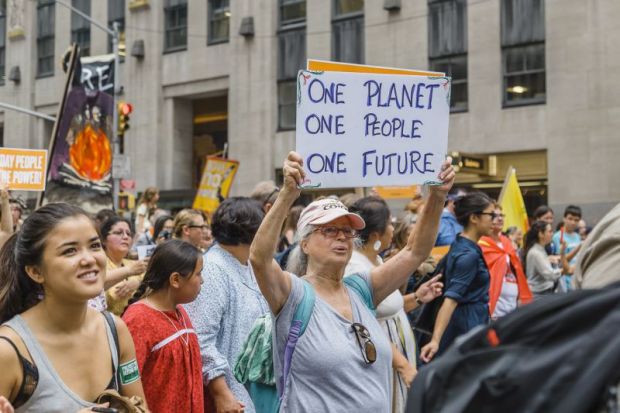Following the release of the latest Intergovernmental Panel on Climate Change (IPCC) report earlier this month, IPCC chair Hoesung Lee said: “We are at a crossroads. The decisions we make now can secure a liveable future. We have the tools and know-how required to limit warming.”
While the report noted that average annual global greenhouse gas emissions were at their highest levels in human history, the rate of growth has slowed. So there is some hope. But is the higher education sector doing enough? Are we making our fair share of the reductions needed?
It is thanks to our universities and research institutes that we increasingly understand our changing climate and its consequences, but we must interrogate whether our emissions policies are consistent with our science. Is our sector’s level of decarbonisation sufficient to limit warming to well below 2°C, preferably to 1.5°C, compared with pre-industrial temperatures, as agreed in the Paris Agreement and reiterated with greater urgency at COP26 last autumn?
While it is heartening to see a steady increase in the number of universities and colleges committing to net zero emissions, the devil is in the detail; the scope of the emissions reductions and the timescales chosen vary enormously and can appear arbitrary. How are these targets being set? I’m not suggesting that greenwashing is happening here, but is science leading our target-setting, or might affordability or achievability be taking precedence?
It is fascinating to see how part of the sector is comfortable with setting stretching commitments, while others take a more cautious and known path. I’m with the former. Declaring a climate emergency and setting currently unachievable targets might seem reckless, but the call to action to the entire university community is clear and powerful. It is time for new thinking and innovation. To paraphrase US executive coach Marshall Goldsmith’s 2007 book title: what got us here won’t get us there. What is a university if it isn’t the space for new thought, innovation, cross-disciplinary perspectives, campus living labs and student-led solutions to respond to the grand challenges of our day – of which climate change is the grandest (and most menacing) of them all?
In February, to celebrate the Queen’s Platinum Jubilee, the Royal Anniversary Trust agreed to support the EAUC, the UK’s Alliance for Sustainability Leadership in Education, in its ambitious plan to establish a sector emissions framework to address the inconsistencies in how institutions report their greenhouse gas emissions. The reality is that we are comparing apples with oranges. Not only does this inconsistency in what and how we are counting impede institutional comparison and collective progress, but it is a risk to our sector’s credibility and reputation. We are the ones producing the climate science, after all.
The next step for our sector has to be science-based targets (SBTs) – targets set in line with the scale of reductions required to keep global warming below 2°C, compared with pre-industrial levels. There are clear international benefits to have an agreed SBT methodology for the further and higher education sector. Resources on SBTs are already in the public domain, so it is an approach that is accessible to all institutions; there is a huge risk in using other approaches to reducing greenhouse gas emissions and setting decarbonisation targets, which may not be in line with the science; and globally SBTs are an increasingly recognised brand by institution leaders and other sector stakeholders.
Several universities in the UK have pioneered the use of science-based targets as a mechanism to track and report their progress in reducing emissions. These include the universities of Cambridge, Nottingham and Surrey and the University of the West of England. Their challenge is that there is no methodology for our sector, nor an agreed mechanism to verify their results. EAUC’s research, both nationally and internationally, shows a significant appetite for a university and college SBT framework that can be applied consistently across the world. So this will be where our organisation and our sector partners take climate action next – to ensure that we are in line with our own science.
Iain Patton is chief executive of the EAUC, the UK’s Alliance for Sustainability Leadership in Education.
See the full results of the THE Impact Rankings 2022, based on the United Nations’ Sustainable Development Goals.
How are global universities performing in the race to net zero? Read our report on the topic.
Register to continue
Why register?
- Registration is free and only takes a moment
- Once registered, you can read 3 articles a month
- Sign up for our newsletter
Subscribe
Or subscribe for unlimited access to:
- Unlimited access to news, views, insights & reviews
- Digital editions
- Digital access to THE’s university and college rankings analysis
Already registered or a current subscriber? Login








